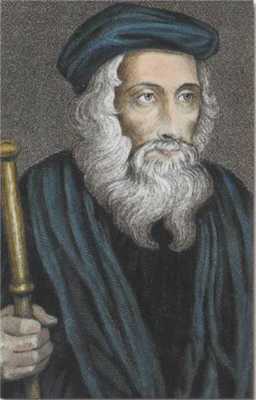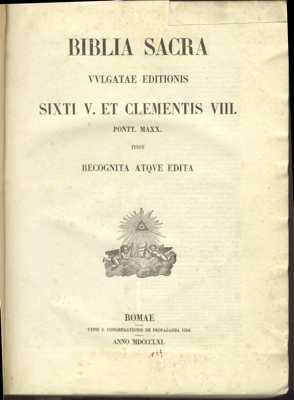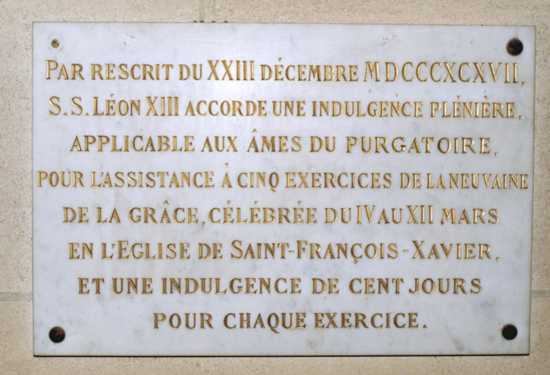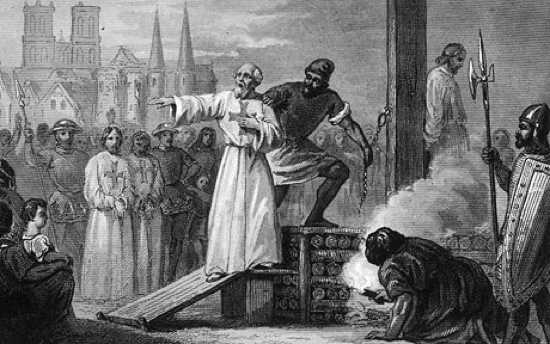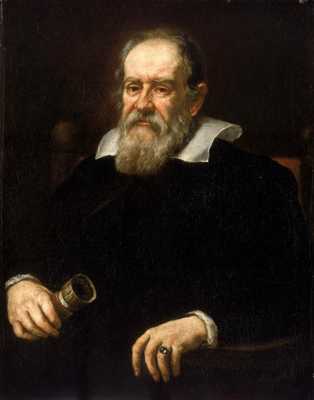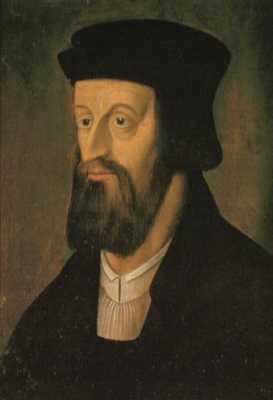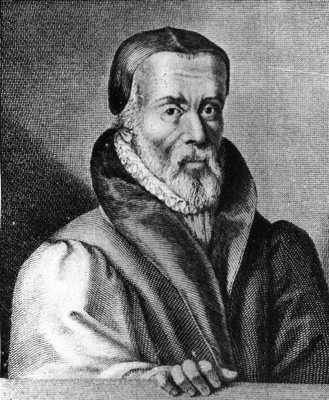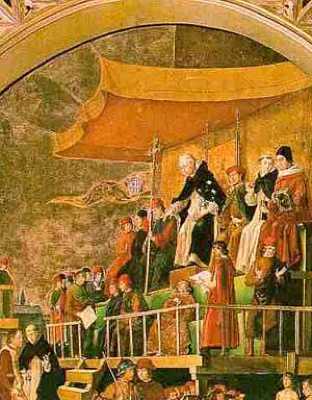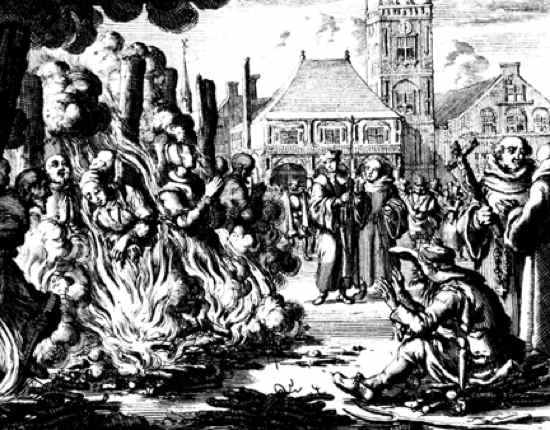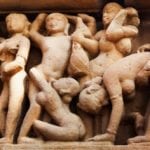In a nutshell, John Wycliffe presaged Martin Luther as a Protestant reformer. Wycliffe lived from c. 1328 to 31 December 1384, about a hundred years before Luther, and Wycliffe saw very much the same problems in the Roman Catholic Church. Catholicism itself was fine with him, but the Church was largely corrupt by his day. A lot of its practices will make entries farther down. Wycliffe wanted people to worship God and Jesus according to the Bible, not according to the popes and their bishops and priests. He saw that people are corruptible, while the Bible is not, and thus, there was no good sense in taking one’s troubles to a priest, so the priest could make one feel better. Communication directly with God, via prayer, was not impossible, but required an understanding of the Bible, and the next entry outlines a specific grievance Wycliffe had with the Church on this subject. Wycliffe preached in England, and on the Continent, that priests should do nothing more than oversee church services and help the laypeople interpret the Bible for themselves. He argued based on various Bible passages that secular kings and queens had a divine right, direct from God Almighty, to be kings and queens. Thus, their rule should not be opposed by anyone, anymore than God’s rule should be opposed. The popes, however, routinely told Europe’s monarchs what was what in every field of activity. It didn’t take long for Wycliffe to irritate a few Catholics, especially Pope Gregory XI. Their animosity toward each other may be without rival in the history of the Catholic Church. Gregory issued no less than five Papal Bulls attempting to shut Wycliffe up, but he would not be silent. Wycliffe went so far as to argue that the pope and the Antichrist were practically equivalent, and denounced the papal throne as the throne of Satan on Earth. He may have been the first to declare this now-popular idea (popular among Protestants). He was the first to translate the complete Bible into English, which did not endear him to the Catholic hierarchy. The Church did not attempt to catch and kill Wycliffe, ostensibly because it could not find him (he traveled extensively in England, France, and the Netherlands), or because it did not like the risk of invading England to get him. He died three days after suffering a stroke during Mass. 30 years later, the Council of Constance ended “the three popes’ reign” and elected Alexander V, who immediately denounced Wycliffe as a heretic, had as many of his books burned as could be found on the Continent and in England, excommunicated and consigned to everlasting flames from the moment of his death. In 1428, Pope Martin V had him dug up and burned at the stake.
Pope Damasus I commissioned Saint Jerome, in 382, to revise the Vetus Latina, which was the compendium of all biblical texts, translated into Latin. Jerome’s product became known as “versio vulgata,” or “common version.” It was the translation used most often from then on throughout Western Europe, and from 400 to about 1530, the Latin Vulgate was the one and only Bible most Western Europeans ever encountered. It is, in fact, still the only official Bible of the Catholic Church. Nothing is wrong with any of this, because Jerome’s translation is perfectly accurate and at its time of publication Latin was spoken throughout most of Europe. It is, more or less, the King James Version in Latin, since the King James translators used it as one of their primary guides. But the problem arose when the commoners throughout Europe told their priests, who told their bishops, who told the popes, that the commoners did not understand the first thing about Latin. It was not spoken except in church ceremonies, and thus, in order to learn it, the commoners had to get their priests to teach them. But the priests would not bother teaching them. Why? Because knowledge is power, and the Catholic Church had all of both. For about 1,000 years, the Bible remained well known only to the church officials, clergy of all orders, and an elect few well educated scholars. It was never counter to any Papal Bull for any person to translate the Bible into another language. However, anyone who intended to do so was strongly admonished by the Pope himself, with every archbishop, bishop and priest of the continent told not to translate the Bible into any language besides Biblical Hebrew, Ancient Greek or Latin. These three languages were almost dead at the time, meaning no one spoke them commonly.
Indulgences are various degrees of the remission of punishments from sins that have already been forgiven. Indulgences are given, not sold, to anyone who performs a Christian act, especially doing a good deed for someone else, or for saying a prayer. This practice really isn’t that un-biblical, in itself, but the problem is that people immediately see it as a “Get Out of Jail Free” card. Sin all you want, then say a Hail Mary, and you’re good to go. It has never worked that way according to the Bible and official Catholic doctrine, and anyone who reads the Pauline Epistles will realize this. But certain Bishops of the Catholic Church saw indulgences as a very good way to get rich, and it worked magnificently. Threaten an ignorant person with eternal burning, and he’ll give you some money to feel safe again. It got ridiculously out of hand from about 500 until Martin Luther spoke against it in his 95 Theses, in 1517. One of the most notorious abusers of the practice was a man named Johann Tetzel, to whom is attributed this infamous couplet, “As soon as a coin in the coffer rings, a soul from purgatory springs.” These Bishops extorted people for years by horrifying them that they’re departed loved ones were currently frying in Purgatory, and would remain there for a very long time, unless their surviving loved ones paid the Church money. This money would atone for the dead persons’ sins, and they would then enter Heaven. Indulgences are not supposed to be sold. If they were, people with lots of money would be holier than thou art. Indulgences are still given in the Catholic Church – some which remit part of the punishment owed for sin, and some which remit all. The most recent indulgences were granted in 2007 by Pope Benedict XVI, for people who took part in pilgrimages to Lourdes.
The origin of the superstition of Friday the 13th began on Friday the 13th of October, 1307. King Phillip IV of Spain had borrowed a very large amount of money and personnel from the Templars, in order to wage war against the English, and when Pope Clement V sent him word that there were suspicions about the Christian nature of the Templar brotherhood, Phillip seized the opportunity, sending his men out to round up, arrest and imprison all the Templars in Spain. Phillip accused them of the most atrocious sins imaginable for that time, including apostasy (which means renouncing Christ), heresy, idolatry and even sodomy. Any one of these “crimes” warranted death back then, and the Templars were guilty of precisely none. But Phillip saw an extraordinary chance to eradicate the Templar order from his entire country and seize its incalculable wealth for himself. He bullied Clement V with political embargoes, and Clement acquiesced with an Inquisition convened to investigate these accusations. The “investigation” involved torturing the Templars via very perverted, horrifying methods, with the single proviso that no blood be spilled. If they died from the torture, it was deemed “righteous punishment.” But none of them did, according to the records we have. Most were put on the rack and stretched until their shoulders dislocated. Some had their testicles crushed in vises, which caused them to bleed profusely, of course, but internally. No blood was spilled. Some were shackled to the dungeon floors and had their feet roasted to the bone in furnaces. They, understandably, confessed to all sorts of horrible offenses to the Church, including the above mentioned, along with spitting on the cross. As soon as their tortures were over, the recanted their confessions. They may have been in possession of the Shroud of Turin at this time, which constituted idolatry. Clement issued a Papal Bull on 22 November, ordering that Templars be arrested and tortured all over Europe, and they were. Phillip IV is the most directly to blame, but the Catholic Church was officially and directly responsible in torturing and executing the Templar knights, knowing full well that they were innocent of all charges. Most of the Templars across Europe actually escaped or were acquitted, but those convicted, including the Grandmaster Jacques de Molay, were, to a man, burned at the stake, most after gruesome tortures. He is said to have screamed out of the flames that Phillip and Clement would both meet him before God, “and that right soon.” They both died within a year; Phillip had a stroke and fell off his horse while hunting; Clement died of natural causes, and a rumor persists that his body lay in state during a thunderstorm, when lightning struck the building and burned it to the ground.
The trial of Galileo Galilei is one of the most infamous and embarrassing moments in Catholic history. It still hasn’t gone away. Galileo seems to have been always at odds with the Catholic Church’s hegemony on all education, even though he was good friends with Pope Urban VIII, and dedicated some of his works to him. But he discovered, via his own pet design for the refracting telescope, that Jupiter has moons, and Jupiter’s moons orbit Jupiter, NOT Earth. Know what that means? Orbits are based on gravity, not mankind’s arrogance. This idea is called heliocentrism, which is, Mr. Sun is at the center of the solar system, and Earth, like everything else nearby, orbits Mr. Sun. Galileo was of the opinion that Nicholas Copernicus was right. The Earth is not the center. The Church didn’t want to hear that. Galileo went to Rome to persuade the Church not to ban Copernicus’s works, and instead of convincing them, the Church officials turned on Galileo and demanded that he desist with his ideas of Heliocentrism. He refused, but did back off for a few years. Urban VIII tried what he dared to help him, but the facts themselves were deemed vehemently heretical, and Galileo was finally brought before an Inquisition (more on those later), and forced under threat of excommunication and torture to “abjure, curse, and detest” heliocentrism. The legend goes that, seated in a chair in a bare room before the table of Inquisitors, Galileo sighed, put his hands behind his back, crossed his fingers and said something to the effect of, “Fine. The Earth does not move around the Sun.” Then, under his breath, he muttered, “E pur si muove,” which is, “And yet it moves.” How much of this is true cannot be ascertained for certain, but at one point he did let his Italian temper get the better of him (after several years of aggravation), when he stood and bellowed, “The Bible tells you how to go to Heaven! It does NOT tell you how the heavens go!” The Catholic Church did not lift its ban on heliocentrical thought until 1758. It was not until 1992, 350 years after his death, that a pope, John Paul II, formally apologized for the Church placing Galileo under house arrest for the last 9 years of his life, and denouncing his discoveries which, ironically, were also incorrect as Galileo taught that the Sun was the center of the universe – not just our solar system. John Paul II’s successor, Benedict XVI, is on record as stating that the Catholic Church’s “verdict against Galileo was rational and just and the revision of this verdict can be justified only on the grounds of what is politically opportune.” Politically, mind you; not factually.
Joan of Arc believed that God had called her to lead the French in kicking the English out of France once and for all. She instigated an uprising in 1429, and led a successful relief force to the besieged city of Orleans, where she aided Gilles de Rais (who, you may recall from another list, was also a savage serial killer), as well as Jean de Dunois and Jean de Brosse, in lifting the siege and routing the English oppressors. Long story short, Joan roused the political irritation of quite a few Catholic honchos in the area. But when they set about opening up a trial against her, they could find no legitimate evidence. But they opened the trial anyway, and also refused to allow her any legal counsel. This was patently against their own rules. During this farce, the inquisitors (French Bishops who favored the rule of the English), especially Jean LeMaitre, tried to trap Joan with her own words, just like the Pharisees and Sadducees tried to trap Jesus with his own words. And Jesus is probably quite proud of how Joan handled herself, because she calmly and carefully turned all their traps back against them. She left them no ground at all on which to base her execution, so of course, they killed her anyway. They hated her and wanted to kill her. In the end, they had to lie. Joan of Arc was executed for heresy, not because she claimed to hear the voice of God, not because she defied and killed the English, but because she was said to have worn a man’s clothing while in prison. This was also forbidden, and thus punishable by being burned at the stake. She requested that her last meal be Holy Communion. The Church officials refused, in essence trying everything they could to consign her to Hell. It was even discovered after her death that she had never worn a man’s clothing. Her case was successfully appealed 25 years later, and she was exonerated by the Pope at the behest of St Joan’s mother. Nevertheless, the Church did not canonize her until 16 May, 1920, five hundred years after she was killed.
Along with the next entry, this is one of the two most appalling incidents of criminal cowardice in the history of the Catholic Church. Jan Hus (c. 1369 – 6 July 1415) was a Czech priest and Catholic reformer who could not stand what he saw as various corruptions rife throughout the Roman Catholic Church. It would take too long to explain every detail of his arguments with the Church, but they can all be simplified to his view that the priests, bishops, archbishops and popes were immoral and given to sin, just as any other human. Thus, any rule the Church established was corrupt, because 100% of the rules necessary for Christian living and salvation had already been written by God in the Bible. He made no secret of his disdain and outright antagonism for the Church in his Prague pulpit. He was strongly influenced by #10, and when #10 died a peaceful death, Hus carried on in his place. He especially wanted the papal schism to end. There were two popes at the time, Gregory XII and Benedict XIII. In 1409, Alexander V was elected to appease both sides, but this backfired. Hus saw it was one more proof that the Church was a human institution, and no longer divine. In 1411, indulgences received a sudden surge of popularity following the death of Prague’s Archbishop, Zbynek Zajic, when Antipope John XXIII advocated indulgences to insure that all those under his bishopric would be cleaned of the sin of following Hus. Hus sternly preached against indulgences. So, in 1415, the Church convened the Council of Constance to put an end to the papal schism, but also to put an end to Hus. They tricked him into coming to the Council under a letter of indemnity, which meant they promised to do no harm at all to him. All they wanted was to talk. While he was there, the Church started the rumor that he was trying to escape the city of Constance (Konstanz). He was not trying to escape, because he wrote his will before leaving Prague. He knew they might try to kill him, and they did, arresting, trying and imprisoning him for heresy. He was held in an underground dungeon, fed very little, contracting the flu and possibly pneumonia. He was ordered to recant his teachings, and he refused, stating that he stood firmly and solely on the Bible, that for the Church to demand his recantation of the Bible was the same as demanding God’s genuflection to the Roman Catholic Church. This infuriated the Church officials, who promptly sentenced him to death. They refused him the Last Rites and burned him at the stake.
Tyndale dedicated his life to translating the Bible into vernacular English, so the laypeople of England could read it for themselves. This was not expressly against the rules, as mentioned in entry #9, but Tyndale could not get anyone in the Catholic Church to help him with room and board. Everyone was uncomfortable with the Bible being readily accessible to the commoners, because how could the Church then keep power? Not to be deterred, Tyndale went into hiding in Belgium and Germany, evading capture while he translated the New Testament, finishing it in 1525. It was printed en masse and smuggled all over Europe, especially into England, where the Catholics in charge burned a number of them in public. Tyndale also wrote fearlessly against the divorce of Henry VIII, calling it anti-Scriptural, and infuriating the king. Tyndale finished translating the Old Testament in 1530. He was finally caught after some help from a backstabbing friend named Henry Phillips, charged with heresy for no other reason than translating the Bible into English, and strangled, then burned at the stake, on 6 October 1536, in Vilvoorde, outside Brussels. The Catholic Church has never apologized. All subsequent English Bibles, including the King James have borrowed extensively from Tyndale’s Bible.
Because they spanned the entire latter half of the Middle Ages, lasting into the 1800s, the Inquisitions themselves deserve their own entry. Their typically accepted dates are from the 1100s to 1808. The Inquisition still exists today, but torture and execution are no longer allowed. The word itself simply denotes an investigation into possible heresy. For those seven centuries or so, anyone who roused the anger or suspicion of the Roman Catholic Church was in very real danger of the arrival of Inquisitors, whose job was “to root out and purge the Christian civilized world of heresy and crimes against God.” Torture was not only defended as a means to gain a confession; the Church encouraged it. Aside from the specific cases mentioned in other entries, it must not be forgotten that the Catholic Church routinely arrested and tortured Jews, Muslims, Waldensianism (Christian), Hussitism (Christian) and numerous other religions and religious sects. These people were given prior warning to vacate the given area (a pogrom), after which anyone found in the area was arrested and given an ultimatum: convert to Christianity or be executed. Anyone who foolishly refused was tortured until he or she did convert, and the Inquisition allowed no exemptions for anyone, men, women, children, the elderly or the disabled. These tortures were lurid beyond belief, including branding, the rack, hanging by the toes or thumbs, toe crushing, bone breaking, simple beatings, foot roasting, and blinding by red-hot pokers. After such tortures, the condemned was almost always strangled, then burned at the stake. For seven centuries, the Catholic Church was all powerful, even terrifying monarchs, and the Inquisition held absolute sway by the most brutal methods imaginable. Interestingly the office of the Inquisition still exists today under the name “Congregation for the Doctrine of the Faith”.
This travesty gets its own entry for several reasons. The so-called “witches” were rounded up and slaughtered for centuries throughout Europe. Casualty numbers vary drastically because records were not well kept, but the average total is anywhere from 40,000 to 100,000 dead, just in the period of c. 1480 to c. 1750. The hunts had been perpetrated for centuries before, and they were carried out for one or both of two reasons: fear and personal animosity. If a particular person irritated someone, the latter could accuse the former of witchcraft, and the Catholic Church showed up like a bloodhound. Or a nation or local government could suddenly become afraid of the influence of the Antichrist and take care of the matter with the Church’s blessing. It was established doctrine that witches were not witches by their own volition, but by Satan’s, and so burning them at the stake would purify them by pain so they could enter Heaven. The Church actually believed, and led the populace to believe, that it was doing witches a favor by torturing them and burning them to death. The methods by which to prove a witch were ludicrous, to state the obvious: a mole or birthmark was deemed proof of trafficking with the Devil; uttering blasphemy (and back then it was nearly impossible to open your mouth without offending the Church); denouncement by another witch (and since denouncing another passed the blame, the accused could save himself this way); to be afraid during interrogation; and the most infamous of all, anyone who could swim was most assuredly a witch, since only the Devil could teach someone to conquer water. Tortures were not always overseen by the Church itself, and thus, the rule of not shedding blood was ignored in these instances. So the tortures became much, much worse: flogging, skinning alive, castration by red-hot pincers, disemboweling, drawing and quartering, head crushing, tooth extraction, de-nailing. Death, if not by torture, was always via burning at the stake. Another very serious mistake the Church made in pursuing and slaughtering people because of the slightest hint of heresy is that in so doing, it also ordered that all witches’ “familiars” be hunted down, killed and burned. These familiars were pets that witches were believed to keep, whether frogs, or owls, or rats or especially cats. From the 1100s until the late 1300s, cats were slaughtered wholesale all over Europe. When the fleas bearing bubonic plague rode on the backs of rats from the Black Sea area and Western Asia into Italy and Western Europe, there were no cats to check the rats’ spread. The Black Death of c. 1340 to c. 1355 spread so well, in large part, because the rats multiplied out of control. The Plague finally dwindled away because the people were too busy dying to kill cats, and the cats repopulated Europe and brought the rats back down. It should be noted that witch hunts were not unique to the Catholic Church, as all of the protestant nations in Europe also partook of this cruel abuse. Alas, no one was immune from guilt.
